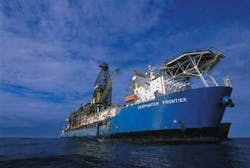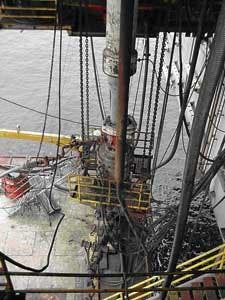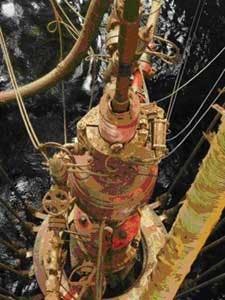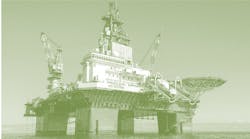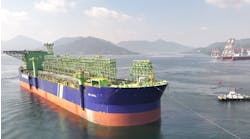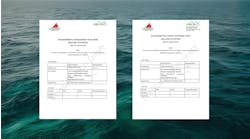John Kozicz, Transocean
Most managed pressure drilling (MPD) practices began in land-based operations. Now these over-balanced or under-balanced operations are emerging offshore in new and effective ways.
Recent development of MPD techniques for use from floating drilling rigs began in the late 1990s concurrent with the development of fifth generation offshore drilling vessels. During this period a number of industry efforts focused on developing “riserless” or dual gradient drilling systems employing subsea mud return pumping systems. One of these efforts culminated with the drilling of a test well in the Gulf of Mexico employing a subsea pump-based dual gradient drilling method. Additionally, during this period another industry group employed aerated drilling fluid and a closed loop circulating system to drill a pressure depleted well section offshore Brazil from a floating drilling rig. While technically successful, these efforts did not result in commercially deployable drilling systems.
Much of the initial industry focus has been on developing MPD methods for deepwater applications. Many of these methods are applicable to all offshore drilling operations and a number of recent applications of constant bottomhole pressure drilling methods have been employed from fixed installations in the North Sea, US GoM, and elsewhere from jackup drilling units.
At the same time, both surface BOP and RiserCap equipment configurations have been employed to implement pressured mud cap drilling from floating drilling rigs offshore Southeast Asia, including theSedco 601 semisubmersible rig in Indonesia.
In November 2007, Transocean employed its patented concentric riser system to enable managed pressure drilling from the dynamically positioned drillship theDeepwater Frontier in 4,920 ft (1,500 m) water depth. In this instance the motivation for employing MPD techniques was to manage a very narrow pore pressure/fracture gradient window (~ 0.4ppg) and to mitigate the potential risks associated with investigating a potential shallow resource located some 820 ft (250 m) below the mudline. This achievement in India was the first use of this equipment by a DP floater in the history of the offshore drilling industry.
Transocean’s concentric riser system is deployed by installing an inner high pressure riser, typically 13 3/8 in. (34 cm), or 9 5/8 in. (24 cm) casing in the rig’s marine riser, followed by installing surface pressure control equipment (annular BOP, rotating control device) at the top of this inner riser, and sealing the lower end of the inner riser with an annular seal.
There are a number of advantages to employing a smaller high pressure riser when using MPD techniques, including the ability to employ higher back pressure than would be feasible with a conventional marine riser; tailor the inner riser and drill string annular diameter to optimize hole cleaning; and better manage equivalent circulating density (ECD).
In all instances to date, application of these techniques (RiserCap, concentric riser) from floaters has been restricted to regions with relatively benign metocean conditions, resulting from the limitations in adapting existing equipment (originally developed for land operations) to floating operations. The most critical of these limitations is the requirement to disconnect the riser from the upper ball joint in order to provide space to install the pressure control equipment. Having the riser disconnected results in accelerated wear of the rotating control device (RCD) elements, increases the risk of drilling fluid spills, and requires manual intervention by riding belt. Additionally, current RCD equipment does not permit fullbore access into the well.
Transocean, working in conjunction with RCD manufacturers, is developing solutions to these limitations, which will ensure broader application of these techniques and drilling methods in all metocean conditions.
Future opportunities
While most of the recent applications of MPD techniques have been focused on mitigating specific drilling challenges related to wellbore pressure environments, a number of efficiency enhancing benefits have been recognized, which are applicable to all drilling operations. These benefits include the capability to quickly and accurately distinguish between wellbore ballooning and influx or loss events resulting in quicker and better informed decisions with respect to managing the wellbore pressure profile. The higher resolution influx/loss detection leads to faster reaction to these flow anomalies thereby limiting the size of initial influxes or losses.
In mature or depleted fields, redevelopment drilling techniques such as through tubing rotary or coiled tubing drilling are currently limited due to high ECDs resulting from very narrow annular clearances. Combining these techniques with managed pressure drilling methods will facilitate drilling of wells which currently cannot be drilled using conventional overbalanced drilling methods. Having the capability to employ these techniques from floating rigs will provide a number of options when contemplating life of field management scenarios during field development planning. Additionally, as these techniques develop a number of subsea fields currently not candidates for redevelopment may become economic.
Having the capability to employ closed circulating systems with enhanced flow and pressure control techniques should lead to reduced risk to the environment from drilling operations. This is particularly important when contemplating operations in environmentally sensitive areas such as the arctic.
Footnote
MPD drilling practices can be categorized as over balanced or under balanced with respect to pore pressure depending on the pressure regime maintained in the wellbore while employing a particular method. Generally, MPD refers to overbalanced at balance operations. The International Association of Drilling Contractors defines MPD as:
… an adaptive drilling process used to more precisely control the annular pressure profile throughout the wellbore. The objectives are to ascertain the downhole pressure environment limits and to manage the annular hydraulic pressure profile accordingly…”
Control of these drilling processes is achieved by manipulating fluid density, friction pressure, and back pressure by employing a combination of:
- Surface or subsea rotating control devices (RCD)
- Surface or subsea choke
- Surface, subsea, or downhole pump
- Wellbore and drill string geometry
- Fluid density management.

